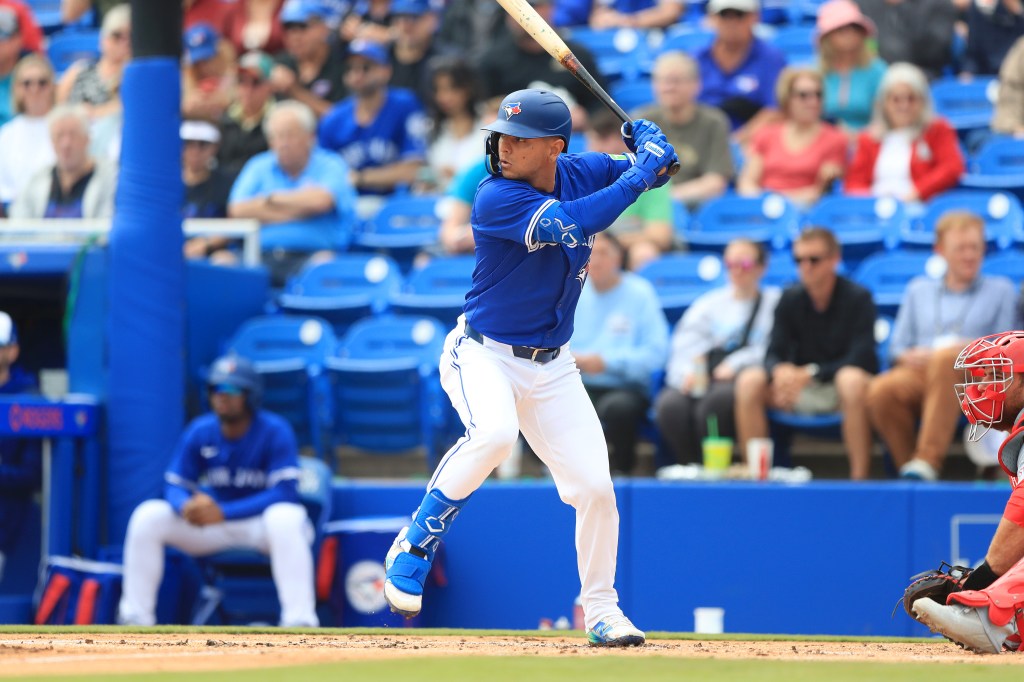Have the Blue Jays Unlocked Legit Power in Andrés Giménez?
Giménez is off to a hot start with Toronto. Has he made some real adjustments, or is this just small sample success?

One of the more unexpected trades at the Winter Meetings this past offseason saw the Cleveland Guardians trade former All-Star second baseman Andrés Giménez to the Toronto Blue Jays.
The Guardians gave Giménez a seven-year extension following a 2022 season in which he slashed .297/.371/.466 with a 141 wRC+ and 6.1 fWAR. In the two seasons that followed, he was still a strong defender but a below-average bat by wRC+.
When Toronto acquired Giménez, he had completed just two of the seven years of his $106.5 million deal. As part of the back-loaded contract, the Guardians had only paid him $7 million in those two seasons.
As for the Blue Jays, they had been looking to add payroll and stay competitive. They parted with the offensive promise of Spencer Horwitz (127 wRC+ in 2024) as part of the swap, evidently deciding that Giménez still represented an upgrade due to that great defense.
In Giménez’s first 10 games with the Blue Jays, he has been nothing short of spectacular with the bat. He’s hit three home runs with an .889 OPS, 150 wRC+, and a bonkers .297 ISO.
Given Giménez’s struggles the past couple of seasons, it’s reasonable to question whether he has made some real adjustments or if this is just small sample success.
In this piece, we’ll investigate both sides of the argument and determine the legitimacy of Giménez’s superb production early on.
Reasons To Believe in Giménez’s Power Production
For the entirety of Giménez’s career, he simply has not been able to hit the ball as hard as a league-average player. So far this season, his average exit velocity is up to 90.1 mph, which is only slightly above league average.
The Blue Jays have been batting Giménez in the cleanup spot in their lineup so far this season, which is good news for him from a production standpoint. Batting behind Bo Bichette, Vladimir Guerrero Jr., and Anthony Santander should give him the opportunity to drive in plenty of runs.
Giménez has also added about 1.5 mph of bat speed from last year. Hopefully this will help to increase his power ceiling.
It’s clear that Giménez has made some mechanical alterations with his new team to increase his offensive output. According to Mike Petriello of MLB.com, he is using a less wide and more open stance. He is also batting “deeper in the box, farther off the plate, and with a much more noticeable leg kick.”
The new batting stance tracking data available on Baseball Savant also shows that Giménez has a deeper point of contact this season.
What’s significant about a deeper point of contact? Well, since he’s added more bat speed, Giménez is able to let the ball travel a bit more before the bat strikes it.
This, along with positioning himself further back in the batter’s box, allows Giménez a bit more time to recognize the ball’s spin and identify pitch type. These adjustments perhaps explain his early 9.3% walk rate, which would be well above his previous career-best.
His new leg kick could be a big reason for the increase in bat speed. It is allowing Giménez to generate more torque and have more force behind his swing.
In summary, Giménez is getting himself into a more powerful position to strike the baseball than he had in prior seasons.
Reasons To Doubt Giménez’s Power Production

There’s no question that it’s been a great start for Giménez in his first 10 games as a Blue Jay. However, there is a long season ahead that can expose the truth about a player’s raw skill set.
It’s nice that Giménez has added that bat speed to help him hit the ball harder, but even with the improvement, he is still in the bottom 20% of MLB hitters in that metric.
Another reason to question Giménez’s power production is that he has pulled a fly ball in the air just 14.8% of the time.
When we use the term “power production,” it’s talking about his propensity to hit extra-base hits and home runs. If he’s pulling the ball in the air at a below-average rate, how can we feel confident that his subpar bat speed is going to lead to legit power production?
So far, the most common batted-ball outcome from a Giménez at-bat has been a ground ball up the middle (25.9%) or a fly ball to the opposite field (22.2%). Neither of these outcomes is particularly conducive to power production.
Giménez’s xwOBA (.334) and xSLG (.418) are fine numbers but still point to some likely regression when compared to his current wOBA (.383) and slug (.541). He seems to be over-performing compared to his expected stats.
Expected stats aren’t everything, but they can definitely show in a small sample size if a player is outperforming their true talent.
Given his batted ball profile so far, it seems that there are real reasons to doubt whether Giménez can keep this up.
The Verdict
To decide whether the newfound power is “legit” for Andrés Giménez, we must first try to define legitimacy itself. To deem his power at all legit, I would need to see Giménez pass his previous career-best mark for home runs in a season, 17.
That doesn’t seem unrealistic, given his increase in bat speed and exit velocity, plus the three home runs already in his back pocket. But is 18 home runs really “legit” power?
In 2025, I think the answer to that question is a pretty clear “no.”
To me, “legit” power would be 25+ home runs. Based on that below-average bat speed and the reluctance to pull fly balls in the air, I have serious doubts as to whether Giménez can achieve that mark.
In 2024, 45 players hit at least 25 home runs. Only one of those players, Angels outfielder Taylor Ward, had a bat speed close to as slow as Giménez’s (69.8 mph). Ward hit exactly 25 home runs in 2024.
Is Ward someone that we would consider to have “legit” power? You could argue for either side, depending on how you define legitimacy in this case. Even if you do answer yes, he is the one unique player that meets this criterion. No other players in 2024 hit at least 25 home runs with a bat speed of less than 70 mph.
Bat speed isn’t everything, but when we are trying to project a player’s raw power potential, it’s pretty helpful. The faster the bat is moving when it strikes the ball at the optimal angle, the higher the exit velocity will be. Harder contact gives a player a better chance to get extra-base hits and home runs.
Popular projection systems ZiPS, Steamer, The Bat X, and OOPSY all agree that Giménez will end up with 16 or 17 home runs in 2025.
We can be generous and give Giménez an extra five home runs on top of that. Even if that were to occur, I simply cannot see Giménez being a “legit” power hitter without adding additional bat speed.


